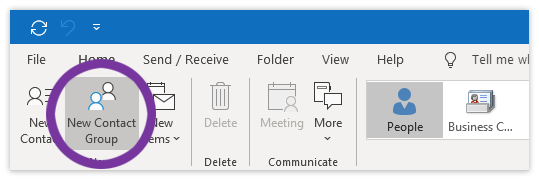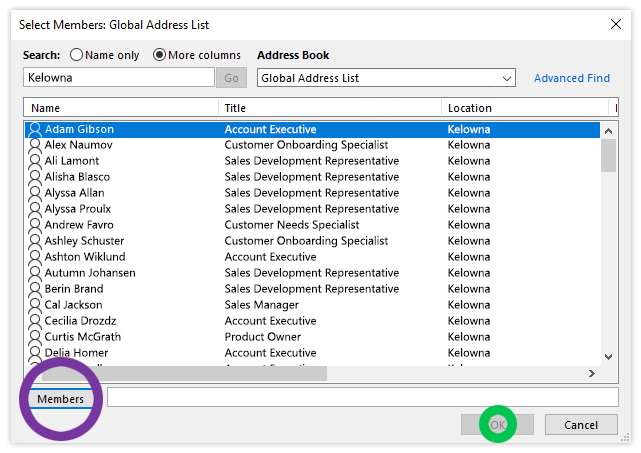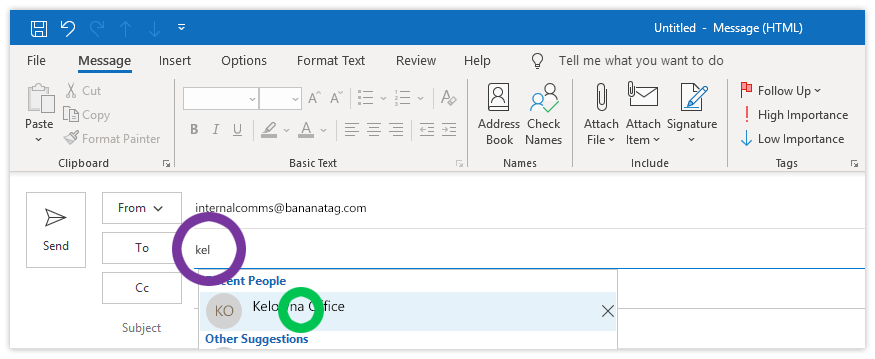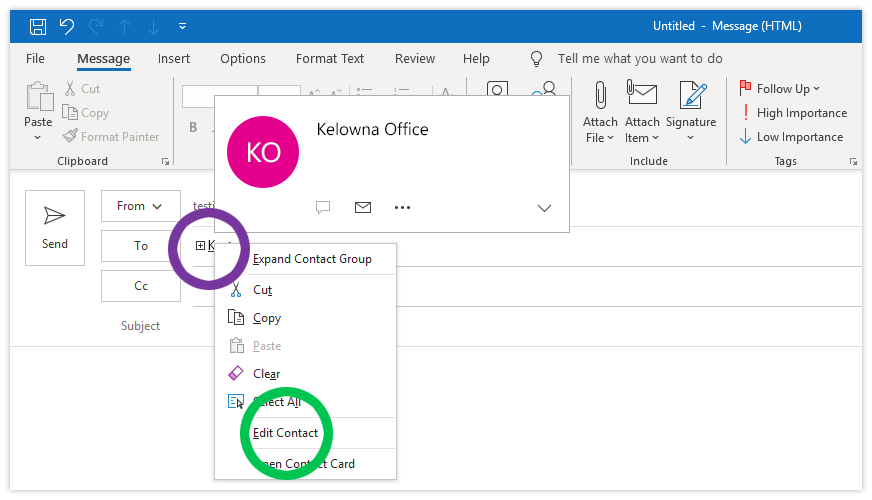How To Add A Person To Outlook Distribution List
Editor's Note: Practice you lot want to relieve this post for later on or send information technology to a colleague? Don't let information technology get lost in your bookmarks!
For many, creating employee distribution lists in Outlook is a necessary evil.
Information technology's fourth dimension-consuming, restrictive, and annoying to manage.
But waiting for It to build you all of the relevant lists you need to segment and target your internal communications could also have millennia.
Then we're going to walk you through everything y'all demand to know about creating employee distribution lists in Outlook, including:
- What distribution lists are and how they work
- The difference between distribution lists, distribution groups, and contact groups in Outlook
- How to create distribution lists in Outlook
- How to update old distribution lists in Outlook
- How to figure out if you fifty-fifty need to exist making distribution lists in Outlook
- What employee distribution lists should you make if yous want more effective communications
- The pros and cons of using Outlook to create employee distribution lists
- The pros and cons of distribution list alternatives
- Our recommendation for the best tool for creating employee distribution lists
What are Outlook Distribution Lists?
Outlook Distribution Lists, also called Distribution Groups or even Contact Groups depending on which version of Outlook you lot're running, are groups of email recipients that are addressed every bit a single recipient.
They're generally used to transport email to groups of people (in your case, employees) without having to manually enter every single email address—which is a large bargain when you work for a large organization and are managing communications for more one location, department, or concern unit.
When y'all're looking at your contact list in Outlook, your Distribution Lists will bear witness up as contacts as well, so they're piece of cake to find and use. They volition also appear in your Address book, when y'all press the "To" button.
What's the deviation between distribution lists, distribution groups, and contact groups in Outlook?
Mostly, these terms tin exist used interchangeably when y'all're referring to them in the Outlook / Microsoft engineering ecosystem.
The term "contact group" is newer than "distribution list" and was probable updated to be a scrap more self-explanatory so as to not confuse users.
In some cases, distribution lists are managed centrally for the unabridged organization, and the emails sent to these lists are commonly sent from an associated email address that internal communications or human resources owns, rather than a personal electronic mail accost.
Contact groups can exist created personally in an private email account in Outlook, then yous tin can build custom contact groups. Keep reading to learn how.
Disclaimer: Building Distribution Lists for Outlook versions released prior to 2013 and Outlook for Mac
The instructions that we outline below simply apply to versions of Outlook versions released in 2013 or afterward.
We're non going to cover annihilation before 2013, so if you're stuck using an ancient version of Outlook, we're sorry (for everything).
Also, keep in mind that if y'all work at a large organization and yous're using Outlook for Mac, making a custom distribution list is pretty impractical. While information technology'south possible to create distribution lists in Outlook for Mac, yous'll have to manually find and select each individual user and add together them to your custom list.
Information technology'southward time-consuming to say the least, but if you feel like doing that, we won't stop you.
How to create employee distribution lists in Outlook
Notation: Microsoft calls distribution lists "contact groups", but they office in the same manner.
Step one: Create a Contact Grouping
Start, open Outlook and navigate to the 'People' tab using the people icon in the folder pane. Yous'll notice the folder pane on the left-hand side of your Outlook screen.

Side by side, click 'New Contact Group' in Outlook's principal ribbon, located at the top of your screen.

Step two: Name and populate your Contact Grouping
In one case you're in the New Contact Group window, enter a name for your grouping. Your group name should be useful, relevant to the group, and easy to notice amidst your other Contact Groups. We recommend naming the group later on the people who will populate it.
For example, let's create a group for Staffbase'southward Kelowna office.

At present it'due south time to add some members from your address book.
You tin select members manually, or you tin can search past fields such equally location or title if you accept this information linked to your address volume. Remember to select "More Columns" before searching for an additional attribute.
You can select equally many contacts equally you desire before clicking the "Members" button followed past "OK."

Step three: Don't forget to save!

Step four: Use those lists!
Congrats! At present yous have your very own, segmented distribution list that you can send to using the same emailing process you lot're used to.
No complicated workarounds needed and no modify in workflow.
Next time you want to send an electronic mail that'south relevant or targeted to your new group, you can just enter your new group name in the "To" field and y'all're all prepare!


How to Update Distribution Lists in Outlook
Updating the distribution lists you create in Outlook is pretty straightforward.
Simply create a new electronic mail, enter the list name in the "To" field and right-click on it.
From there you can reopen the contact grouping window and add or remove members.

half dozen Employee Distribution List Best Practices for Outlook
1. Keep them up-to-date . . . or else!
There are three big problems that volition arise if you lot don't keep your employee distribution lists up-to-engagement.
First, if you're tracking email metrics like opens, clicks, or read time (which is a very smart and cool matter to do), sending internal communications to people who have left the company and therefore can't open the email volition transport your date metrics into the ground.
Non only will it exist a false indicator of how well your content is actually performing, you'll likely have to justify the date crash to leaders. And if you lot have to explain that the numbers are off considering of out-of-date lists, information technology may then be a struggle to go stakeholders to trust the data you lot're collecting, hurting your ability to influence the strategy for the channel.
2nd, if y'all're targeting a specific segment of employees, by something like location or department with important data similar policy or health and safety protocols, important people could be left out of the loop. That would not be good.
And finally, if an employee has left, their director is likely going to get their forwarded emails. If your lists don't stay up-to-date, those managers are going to receive your emails twice. This will non only exist annoying but it will skew your metrics as well, bringing us back to the initial betoken near bad data.
If y'all have the option, opt for dynamic list creation that syncs with your HR system or other employee records program.
ii. Create a system
Next, figure out and set up a process for how you're going to utilise employee distribution lists across your organization. (Trust us, you'll be thankful yous did.)
First, determine whether you want to divide internal audiences and external stakeholders who might also receive your internal communications. Sometimes when you lot're measuring the engagement of these audiences or if you have to tweak information you ship to each group, you'll want to separate them out. Stakeholder engagement might as well impact your email date rates which won't give you lot an accurate moving-picture show of what'southward really resonating with employees.
Side by side, create lists for every relevant department, squad, location, and business unit.
And and then, create rules or protocols for when an email should go to an all-staff distribution listing and when communications should exist more targeted to specific lists.
These are just the starting time steps in creating a proficient employee distribution list system. Every arrangement and internal comms team is unique, then go on edifice until you lot've fleshed out processes and systems that cover all of your bases.
3. Keep information technology consistent
Develop a naming structure or descriptive organization so that no affair which user needs to send to which list, they can easily discover the right data.
You should as well decide which communications are going to come up from which email address. This may non seem like a big deal, but having emails come from a consequent source is a all-time practice because it helps to ensure that emails don't get missed by employees. If information technology's always coming from the same address, they'll expect information technology and know emails coming from that accost are important.
And sender trust is fundamental to getting those emails opened and clicked.
Also, don't forget to keep your sending addresses short and easy to identify and so they don't look similar scams addresses or spam.
iv. Decide on ownership
If Information technology doesn't need to have ownership over the lists, decide who else can and should manage the lists, and how they'll get the information they need to create new lists and update existing lists.
This may mean working with IT, 60 minutes, and other internal departments that communicate to the whole organisation. It'due south key to develop these procedures and relationships early to avoid problems like inaccurate, out-of-date lists.
5. Build a relationship with Information technology
Often, you won't have control over distribution list cosmos, so it's important to communicate with IT about what lists you need, how oftentimes you'll demand them updated, and the procedure for requesting updates and changes. Having this adamant at the commencement volition help yous avert headaches and disharmonize in the long run.
We take heard a lot of grief from internal communication professionals who don't accept the best relationship with IT or fear asking them for things considering the process seems long and arduous.
And we become it. Sometimes information technology is a pain.
But investing in these relationships — not simply with It but with departments like Hr — volition have tremendous returns yous'll be very thankful for later.
half-dozen. Avoid reply-all drama
Every once in a while, someone receives an all-staff email, decides to respond, and ends up sending an e-mail to every single person on the list.
That's why it'southward fundamental to create moderators for your distribution lists if you're using Outlook.
Messages sent to a chastened distribution list are screened by a designated moderator before being sent to all members of the group, stopping respond-alls in their tracks. Hallelujah.
If you own a list, you lot can set up moderation rules for information technology by going to its settings and adding moderators in the "Message Blessing" settings.
How Should Y'all Segment Employee Distribution Lists?

In brusque: however you want to.
At that place are loads of dissimilar ways to segment your lists and then you're creating relevant, targeted employee communications.
But a groovy place to start is with these seven employee segments:

i. Part locations
Information technology's pretty annoying getting emails that aren't relevant to your office or location.
We've also learned immediate from our customers that location-based lists are not only of import for timely, location-specific communications—but are as well disquisitional for crisis communications.

2. Working style
If your organisation at present has hybrid workers, y'all may wish to communicate with these groups independently, particularly if you lot send communications such as facility updates that are only relevant to employees who are working at that particular location.
iii. Leadership teams or managers
Demand to prep your leadership team in advance of sensitive company-wide communications?
To make sure you lot're sending the correct letters to leadership, break down your employee listing past seniority or leadership level.
We've too seen organizations where managers may have company email addresses but private employees do non, like in retail or manufacturing. In cases like that, we recommend building a distribution list of managers who are responsible for sharing corporate communications with their item teams.

4. Chore function or department
The experience that employees have in your arrangement is inherently linked to the team or department in which they work.
Reaching employees with targeted emails based on their job function or department will enable you lot to ship relevant data to big groups of similar employees, and be more responsive to any result that affects specific teams or departments.

5. Specific concern divisions or units
Like to segmenting employees based on their job title or department, targeting communications to larger business units, divisions, or specialized groups allows you to cut out data from your all-staff communications that are but really important to these specific groups.
How your organization is structured will inform what kind of groups or divisions you target. For case, you could group together all employees on the East Coast, all manufacturing teams, or all client-facing departments.

six. Primary language
For enterprises with offices effectually the earth, having an employee distribution list for each language tin help you make sure your messages resonate.
By targeting employees in their preferred or primary linguistic communication (regardless of their physical location), you take the opportunity to translate or adjust important messages to ensure they are understood.
vii. Tenure
Many organizations have unlike benefits and perks available to their employees based on how long they've worked at the company.
If y'all want to share information about benefits that are sectional to long-time employees, you may want to segment your comms to avoid confusion.
Should y'all use Outlook Distribution Lists for Employee Communications?
Now that nosotros've covered about of the ins and outs of Outlook Distribution lists, a question remains: Are Outlook Distribution lists the best option for your employee communications?
The Pros and Cons of Outlook Distribution Lists for Employee Communications
The Pros
- The quickest way to build a distribution listing (if your organization has flawless contact data in Outlook).
- You likely already have admission to create them.
- They're straightforward for the tech-savvy user.
The Cons
- You can't get analytics comparison electronic mail performance across different lists.
- Potential for reply-all drama.
- Crave updating frequently.
- Earlier versions of Outlook take limits on the number of addresses you tin include, typically between 50-70 contacts.
- You tin can't exclude certain recipients from your communications if they're already on the distribution list, unless you individually remove them.
- Even though Outlook 2010 and subsequently versions allow unlimited addresses in distribution lists, your corporate surroundings, server, or even internet access provider may limit the size of your groups and cake emails that take more recipients.
- Emails that have a lot of recipients are more oft marked every bit spam by the recipients' e-mail provider.
- If you lot send to a Contact Group or Distribution List using the "To" or "CC" field, Outlook may expose all of the recipients' email addresses to each recipient. This tin accept up a lot of space at the top of the email and also may be a privacy issue. While you can "BCC" a Contact Grouping, this is an piece of cake pace to forget if y'all ship a lot of emails.
- Can be difficult to get support if you're having problems. You'll likely have to get through your ain Information technology team or expect for community responses on their support forums. When something isn't working, this may mean your important communications are delayed while you wait for help.
3 Outlook Distribution Listing Alternatives
Afterward reading all this, you may be thinking that Outlook Distribution Lists are more trouble than they're worth. And you're not entirely wrong.
But in most large organizations, email clients are standardized across the entire company for security and operational reasons.
So what are your options?
Luckily, there's nevertheless hope. We've talked with plenty savvy internal communication professionals to know that there are some workarounds that may piece of work for you lot besides.
1. Microsoft 365 Groups
If you're already using Microsoft 365, you can update your distribution lists to get "Groups." This will allow you to dodge a lot of the drawbacks we listed to a higher place most using Outlook distribution lists.
Merely keep in mind that these "Groups" are not purpose-built for internal communication broadcasts. They were originally intended to facilitate cross-team collaboration past having 1 identify where groups could come to share documents, discussions, notes, and files.
As well note that in social club to use "Groups" in Outlook, you demand to have a Microsoft 365 plan that supports Exchange online and SharePoint online, such as Business organization Premium, E3, or E5.
The Pros
- Creating new Groups is relatively easy.
- 365 Groups are a core characteristic and are oft being improved.
- Have shared inboxes.
- Like shooting fish in a barrel to add together and remove members.
- Dynamic membership allows y'all to set group membership settings that automatically add together or remove group members based on data from Azure Active Directory, so your lists stay up to date then long as your Active Directory is up to date.
- Groups can be fix to private or public, allowing more people to follow if they're interested in certain content or departmental updates.
- Gives members admission to a shared certificate library, which is bang-up if y'all share a lot of linked-out content in your emails.
- A group can be created forth with an associated SharePoint library, OneNote notebook, Microsoft Teams, Yammer, Planner, and PowerBI.
The Cons
- Groups were built for collaboration across teams, not specifically for sending emails, and so a lot of the functionality volition go unused or may be confusing.
- You must be a global admin or Exchange admin to upgrade lists.
- Many kinds of distribution lists cannot be upgraded.
- Members accept to be "following" the group in order to go messages in their personal inbox, otherwise they have to go to the group's shared inbox to read messages.
- One time y'all proper noun a Group it cannot exist changed.
- When you upgrade your distribution lists to Groups, everyone in the grouping will go a welcome email, which might misfile employees, and so yous'll accept to do some onboarding.
- Technically, employees tin can leave groups and you can't easily terminate them.
- To get dynamic group membership, you need an Azure Ad premium subscription.
- All members of a group are automatically granted permissions to edit shared data, including documents.
- Can be hard to get support if you're having problems.
The Verdict
Microsoft 365 Groups were built for collaboration betwixt users, which tin can be an attribute or a drawback, depending on how your departments and teams are fix.
If y'all're just sending emails, you're meliorate off using Distribution Lists. If you need additional collaboration features, use 365 Groups.
2. External marketing tools
There are soooooo many marketing platforms that allow you to send bulk emails to specific lists. (MailChimp, Constant Contact, MailierLite to name a few.) And they all offer a suite of delicious features similar drag-and-drop email designers, tracking, and date metrics.
Only a word of alarm: these fancy tools are built for marketing, not internal communications, so they can pose some barriers you may not be able to work around.
The Pros
- If yous accept a small plenty list, some of them are costless.
- They are usually pretty convenient and intuitive.
- They come with pattern and metrics features.
- They permit a lot more flexibility with branding and blueprint, allowing y'all to make more engaging emails.
- You can schedule and automate emails.
- You tin can personalize emails using merge fields.
- Some platforms allow you lot to identify and re-send to contacts that didn't open the email.
The Cons
- Employees tin can unsubscribe (all of these marketing tools crave an unsubscribe push by law).
- Emails sent from marketing platforms are more likely to be marked every bit spam.
- Potential security and legal issues with storing company email addresses on a marketing platform not congenital for purpose.
- Updating your lists will exist 100% manual.
- External marketing tools often create spider web versions of your emails, which are technically discoverable and a big privacy business organisation.
- Employees may not be stoked that their engagement with your email tin can exist tracked individually.
- Lack of individual support if you lot're having issues with the platform.
The Verdict
External marketing tools are a fine selection if y'all don't have whatever other options. They are definitely a step up from having to do everything in Outlook, just you lot volition inevitably run into security, deliverability, and unsubscribe bug.
3. Create Custom Distribution Lists in Bananatag
Creating Custom Distribution Lists in Staffbase is pretty not bad (if we do say so ourselves).
And this is mainly because our tool was purpose-built for internal communications and is upgraded often based on feedback from internal communication professionals.
To create a distribution listing, users just have to open up up their employee app or intranet and navigate to the Contacts tab.
The Pros
- Super convenient interface that works rapidly.
- Y'all don't demand Information technology to create new employee distribution lists.
- You lot can create dynamic distribution lists that sync with Azure Active Directory, and before long HRIS systems, then you always have authentic, upward-to-appointment lists.
- Y'all can upload and update lists using a simple CSV.
- You tin schedule your communications.
- You tin can segment your email stats based on location, department, or other attributes stored in your HRIS.
- You lot can get together authentic date information across shared workstations and digital workspaces.
- You lot can follow up with merely those employees who didn't open up your email, without seeing individual-level information, keeping employees' privacy at the forefront.
- You tin can view a breakdown of email stats by segment, then that you lot can compare how the same message is received by dissimilar audiences.
- You get access to Staffbase's awesome features, like our collaborative email designer, pulse survey features, metrics, and more.
- An amazing support team has your back if y'all need help with everything from technical difficulties to strategic advice.
The Cons
- Yous have to exist a Staffbase client (which is definitely non a bad thing).
- You'll be kicking yourself considering you didn't switch sooner.
- Staffbase is an enterprise product typically used by organizations with 500+ employees
The Verdict
If you're sending to more than 500 employees, in that location isn't a more flexible or convenient option.
The Winner: Staffbase
We're simply slightly biased, but hear us out.
Based on the pros and cons of all the options, you'll likely agree that on paper, Staffbase's features and functionality should get the job done rapidly and easily, while besides being Information technology and legal-friendly.
We built our platform for internal communications past listening to what internal communication professionals really need from an employee electronic mail solution.
And in the end, having something purpose-congenital that's always being improved will save you lot headaches, energy, and hours of your time.
Want to see for yourself?
Reach out to the states here at Staffbase and we'll set up y'all up with a customized demo. You can take our email designer for a spin and see for yourself if we're really the all-time option.
How To Add A Person To Outlook Distribution List,
Source: https://staffbase.com/blog/how-to-create-distribution-lists-in-outlook/
Posted by: kellylithen.blogspot.com


0 Response to "How To Add A Person To Outlook Distribution List"
Post a Comment